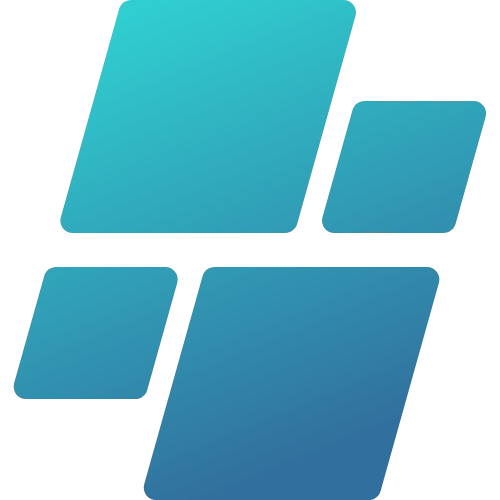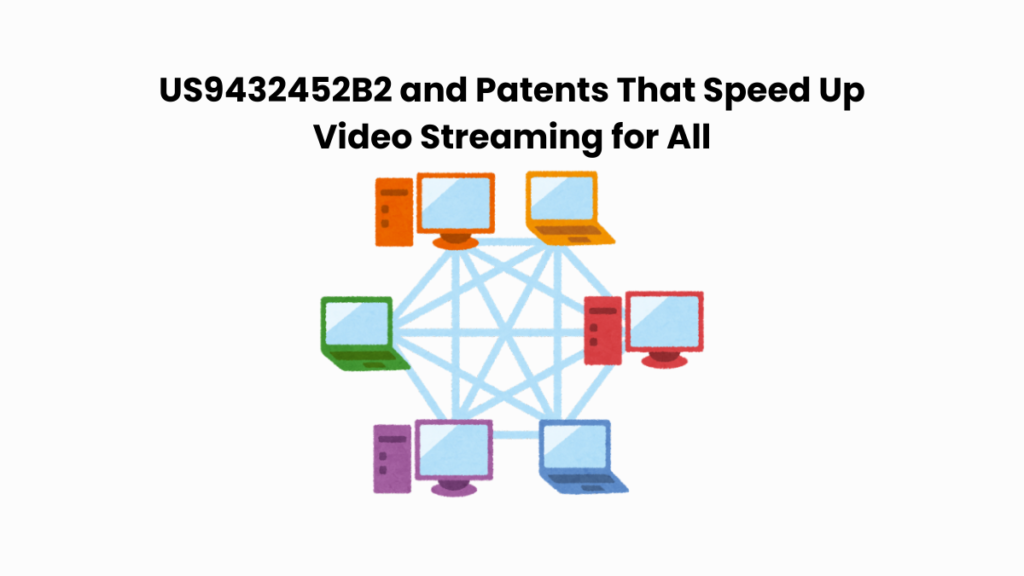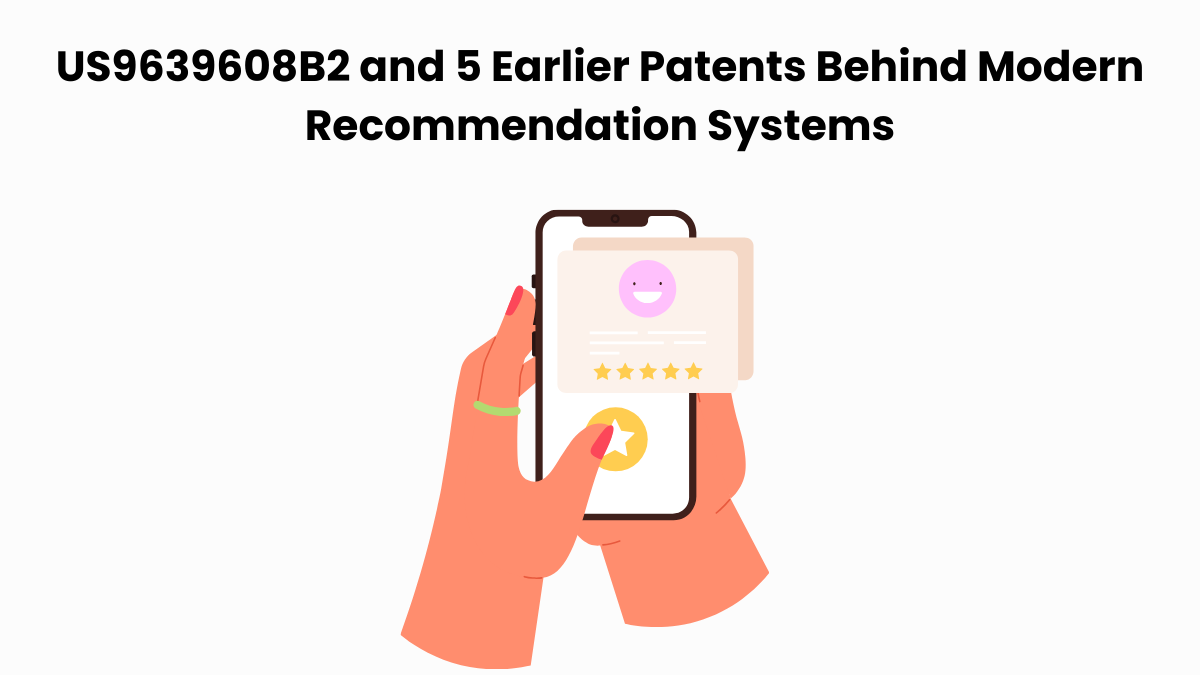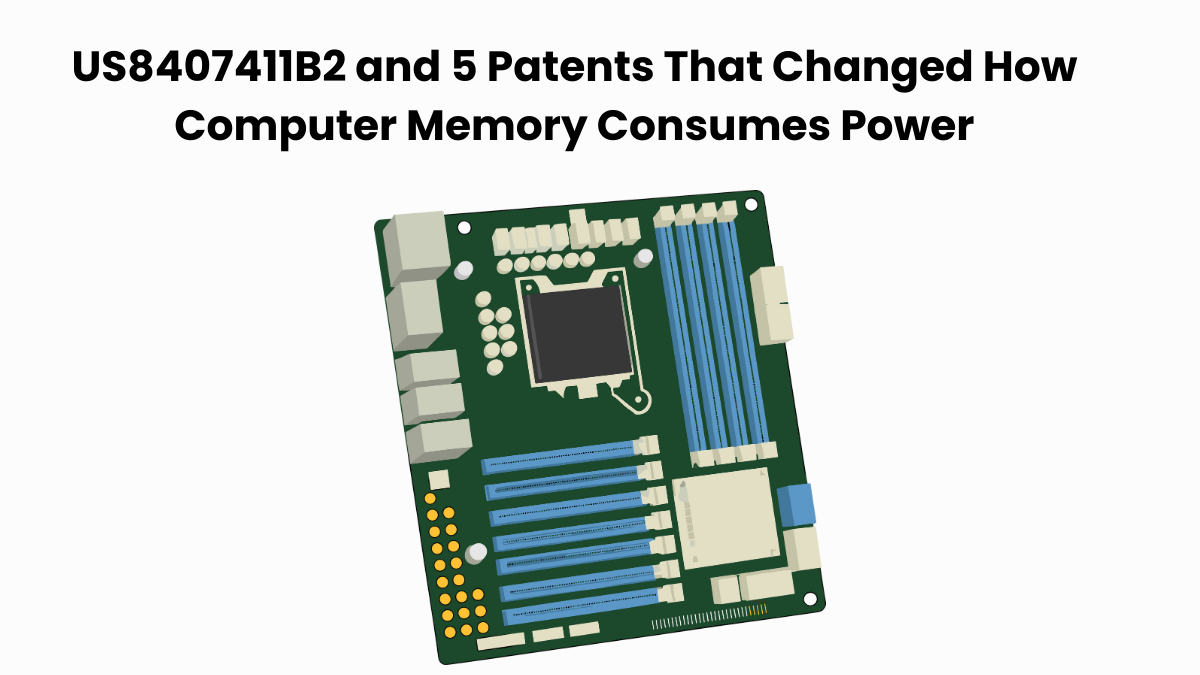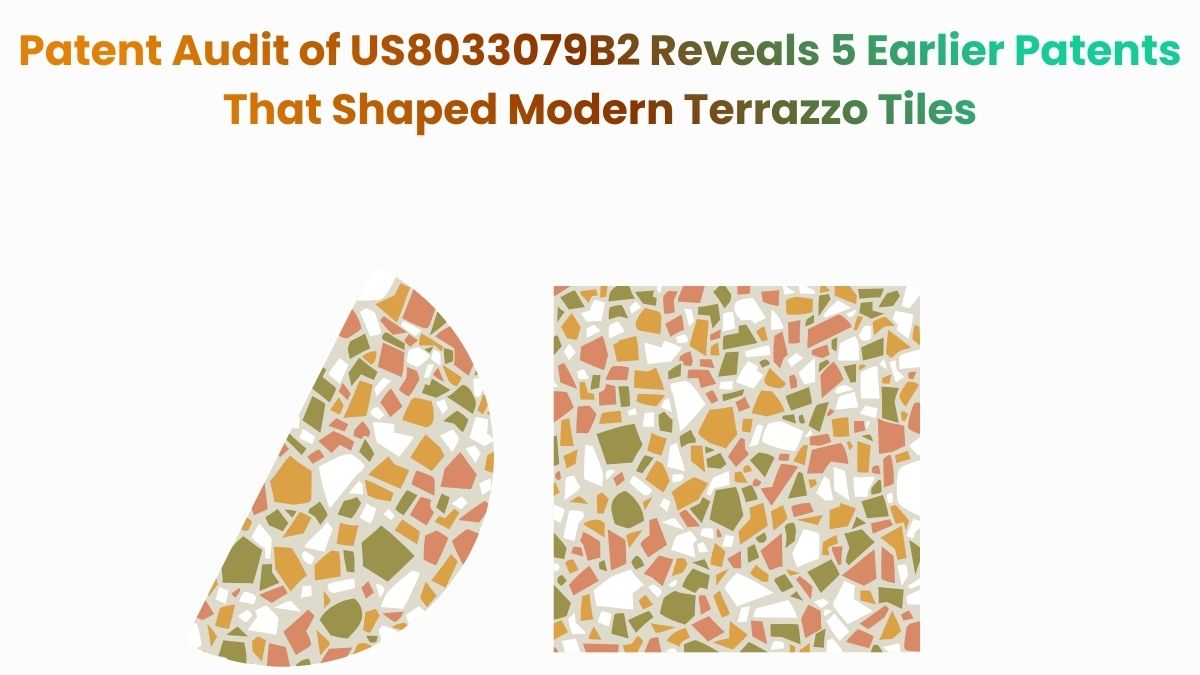When thousands of people stream the same video at once, traditional servers struggle to keep up. It results in lag, buffering, and uneven playback that ruin the viewing experience.
Patent US9432452B2 changes that. It introduces a peer-to-peer streaming method where users watching the same video share small portions of it directly with each other, instead of relying entirely on one central server. This distributed approach lightens the load, speeds up delivery, and keeps streaming smooth, whether it’s a live concert, a sports event, or a viral video.
Although the patent is cited in Cooperative Entertainment, Inc. v. Vocal Technologies, Ltd., this article focuses on the technology itself, and how it reshaped large-scale digital streaming.
Using the Global Patent Search (GPS) tool, we’ll also explore similar inventions that tackle the same challenge: delivering high-quality video faster, smarter, and more efficiently.
How Patent US9432452B2 Reinvents Peer-to-Peer Streaming
US9432452B2 covers a system for sharing large digital files, like videos, between people who are watching the same content simultaneously. Instead of downloading from a single source, each user can exchange video segments directly with others. This creates temporary, self-organizing peer networks that form in real time based on who is viewing the same stream. The approach accelerates content delivery and eases pressure on main servers.
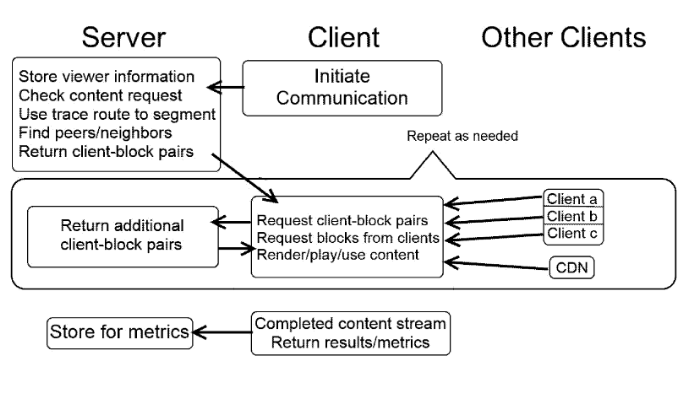
Source: Google Patents
What US9432452B2 Covers: Technical Highlights
1. Peer-to-peer sharing based on common content: Users are grouped if they are watching the same content, allowing them to share it directly.
2. Dynamic networks created in real-time: The system forms temporary groups based on internet routing paths, not fixed server locations.
3. Content delivery happens outside controlled networks: Sharing is done outside typical content distribution networks, improving flexibility.
4. Automatic grouping and re-grouping of users: Users are added to or moved between groups based on how they connect and what they watch.
The system supports fast content streaming, real-time sharing, and caching for smoother playback. It can work without special software, using standard browsers. It also enables targeted ads, group size management, and rewards for users who share content. These features enable the system to be scalable, efficient, and adaptable across various types of media and devices.
To see another example of platforms adapting content based on user context, you can check out our analysis of US8078498B2, which covers how e-commerce systems adjust store displays depending on the shopper’s location.
Technologies Expanding the Idea Behind US9432452B2
To understand the technology behind US9432452B2, we used the Global Patent Search platform to uncover similar patents. These references focus on peer-to-peer file sharing, community-based streaming, and systems that optimize content delivery using dynamic node selection.
1. US2008134258A1
This U.S. patent, US2008134258A1, published in 2008, introduces a way for people to share video content with others in the same peer-to-peer (P2P) network. Each person in the network can watch content that was downloaded or recorded by someone else. The system is designed for streaming video on demand without relying only on a central server.
Below, we have added snapshots from the GPS tool displaying the relevant snippets from the specification for similar patents.
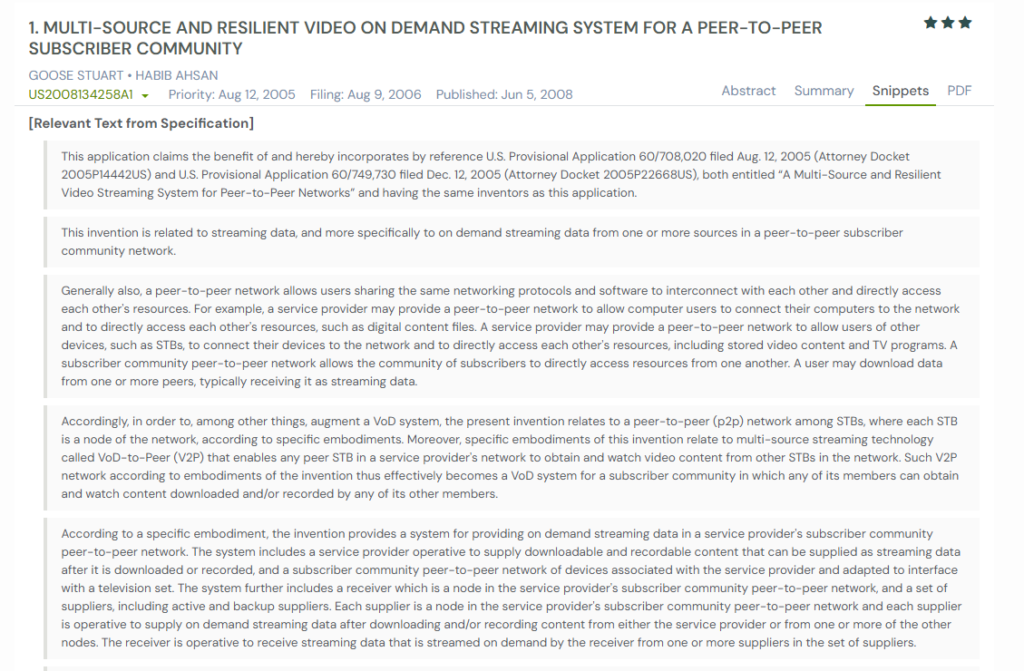
What This Patent Contributes to the Technology Landscape
- A peer-to-peer video sharing system for users in a subscriber network
- Use of multiple sources (suppliers) to stream the same video content
- Backup suppliers that step in if active ones fail
- Peer selection based on bandwidth, reliability, and past performance
- Buffer management to prevent video freezing or skipping
- Smart error correction during data transfer
- Search tools to find available videos on other users’ devices
- Interactive controls like pause, rewind, and fast-forward
- Support for both slow and fast internet connections
- Ability to sync slightly different copies of the same video file
- An incentive system to reward users who share their content
- Dynamic rate adjustment based on network performance
Shared Foundations with US9432452B2
- Both patents use peer-to-peer sharing to deliver video and large digital files.
- US2008134258A1 forms a network where users share stored content, while US9432452B2 shares real-time streams
- Each system avoids relying only on central servers by using nearby users as content sources.
- Both improve delivery speed, reduce strain on networks, and maintain service when users drop off.
- Dynamic peer grouping and content-based sharing are core to both designs.
US9031537B2 follows a similar philosophy of distributed decision-making by optimizing wireless handover to maintain stable connections during real-time media delivery.
Why It Changed the Way We Stream
This patent shows how peer networks can support video streaming without needing a central server. It highlights the value of sharing content between users to reduce delays, avoid buffering, and create a more flexible content delivery system.
2. US2008160911A1
This U.S. patent, US2008160911A1, published in 2008, introduces a peer-to-peer broadcast system for delivering video content like TV programs. Instead of depending on one central server, it uses a network of devices (called peers, super seeds, and relays) to split and distribute video files. When a user requests a video, the system finds the files across the network and sends them piece by piece from different locations.
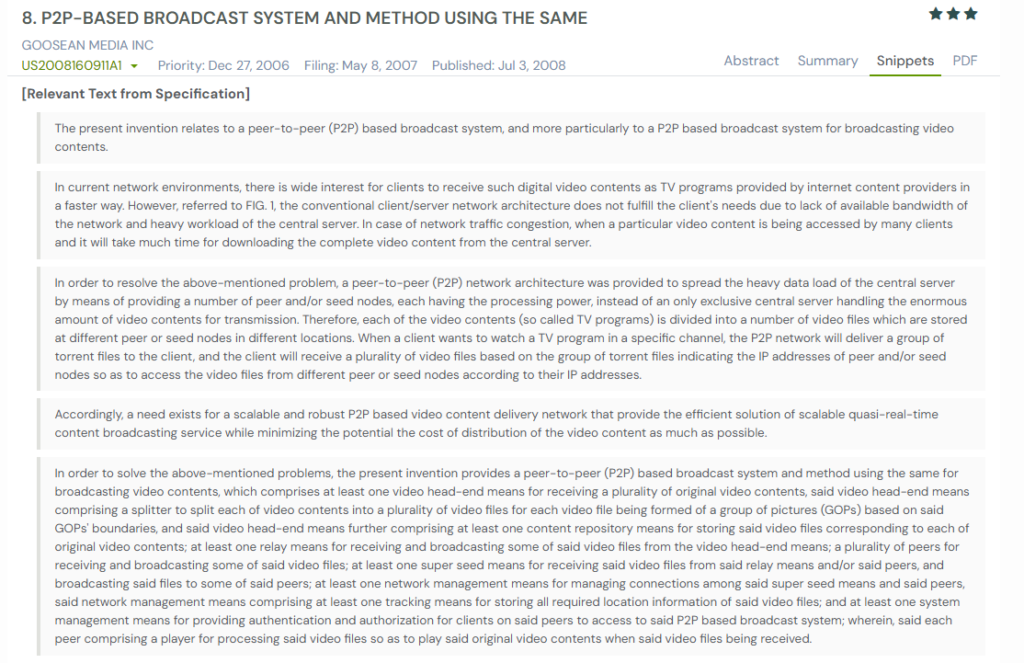
What This Patent Contributes to the Technology Landscape
- A peer-to-peer broadcast system for streaming TV and video content
- Use of video file splitting based on group of pictures (GOP)
- Distribution through multiple nodes, including peers, relays, and super seeds
- Each peer can act as both a receiver and a broadcaster.
- A tracking server that stores the location of all video files
- Real-time streaming through decentralized delivery
- Peer nodes with built-in players that decode and display video
- Support for user authentication and access control
- Use of torrent files to identify where video parts are stored
- DRM (Digital Rights Management) for secure playback
- Compatibility with regular PCs and set-top boxes
- Video playback that starts as soon as pieces begin arriving
Shared Foundations with US9432452B2
- Both patents use peer-to-peer networks to distribute video content efficiently.
- US2008160911A1 splits videos into smaller files and shares them across peers, like dynamic content sharing in US9432452B2
- Each system avoids central servers and relies on user devices to support streaming.
- They both focus on delivering content in real time using decentralized infrastructure.
- Each peer group is built around shared content, which is key to both inventions.
Why It Changed the Way We Stream
This patent shows how video content can be delivered efficiently using a network of users instead of one central source. Like US9432452B2, it forms temporary groups based on who wants to watch the same video, helping reduce traffic on main servers.
Related Read: US7203844B1 and similar patents explore layered encryption methods that secure streaming data across peer-to-peer networks. It adds another layer of protection to media sharing systems. Read the article to know more.
3. US2011219137A1
This U.S. patent, US2011219137A1, published in 2011, introduces a system for sharing live video or audio using a peer-to-peer network. Traditional peer-to-peer setups are designed for downloading full files, but they struggle with real-time streaming.
This invention solves that by sharing smaller parts of a live stream between users within a time limit, so playback stays smooth.
What This Patent Contributes to the Technology Landscape
- A peer-to-peer system for streaming live video or audio with time-based delivery
- Division of content into small, timed blocks for smooth playback
- Nodes that share and receive stream data within set time windows
- Coordination through control and data messages sent on separate channels.
- A central server that helps assign and monitor stream delivery
- Each node can act as both a sender and a receiver.
- A deadline system that ensures the timely delivery of stream data
- Block availability tracking to help nodes choose the best source
- Queues for incoming and outgoing data with time-based scheduling
- Options to skip outdated blocks that arrive too late
- Control of how many times each data block is shared in the network
- Support for rare content prioritization and smart data requests
Shared Foundations with US9432452B2
- Both patents use peer-to-peer sharing to deliver content efficiently and at scale.
- US2011219137A1 focuses on real-time streaming, while US9432452B2 enables live and near-live delivery
- Each system avoids overloading central servers by using users to relay content.
- Nodes in both systems form temporary groups based on who is watching or consuming the same content.
- Time-based block delivery in US2011219137A1 reflects the dynamic grouping in US9432452B2.
Why It Changed the Way We Stream
This patent introduces a method for streaming live content smoothly across multiple users without relying solely on central servers. It shows how breaking the stream into timed parts and sharing them through nearby nodes keeps video or audio flowing without delays.
Home networks rely heavily on knowing which devices truly belong. Our deep dive into US8037161B2 and similar identification patents explains how this trust layer evolved.
4. JP2003169089A
This Japanese patent, JP2003169089A, published in 2003, introduces a method for streaming video or audio directly between user devices on the internet, eliminating the need for a powerful central server. It allows regular user devices like personal computers, mobile phones, or digital cameras to receive, play, and forward live stream data to other users.
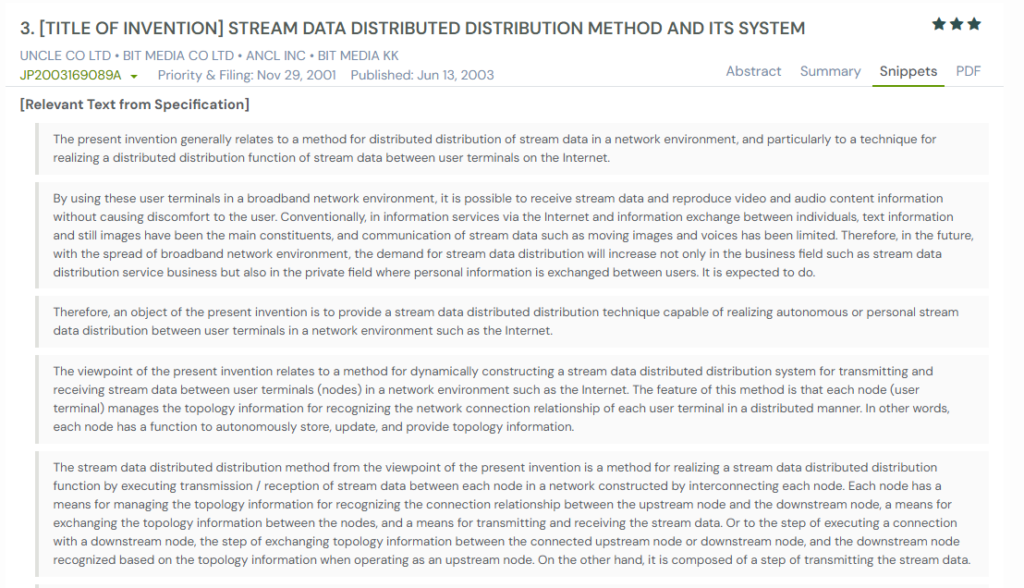
What This Patent Contributes to the Technology Landscape
- Peer-to-peer streaming without a central server
- Each device (node) can receive, play, and forward stream data.
- A topology engine helps nodes manage and update their network connections.
- Automatic switching of upstream and downstream connections if the network changes
- Nodes can connect to multiple downstream users simultaneously.
- Support for real-time playback while streaming data is still being relayed
- Use of TCP/IP for reliable data exchange and control messages
- Flexibility to stream video from personal devices, such as digital cameras
- A lightweight mediator server only helps with introductions, not stream control.
- Ability to run entirely without central control if peers know each other
- Relay control based on network conditions and user capacity
- Nodes can disconnect or reconnect without breaking the stream chain.
Shared Foundations with US9432452B2
- Both use peer-to-peer distribution for video or stream data.
- Each system builds temporary networks based on shared content consumption.
- JP2003169089A uses topology management, while US9432452B2 uses trace route-based dynamic grouping
- Neither system relies on a high-capacity central server to serve all users.
- Both aim to reduce delivery costs and handle large user numbers with distributed sharing.
Why It Changed the Way We Stream
This patent shows how everyday users can become part of a live streaming network without needing expensive infrastructure. Just like US9432452B2, it forms a content-sharing group where users both consume and forward video streams. The network can grow or adjust itself when users come and go, making it ideal for events or personal broadcasts.
5. US2012084392A1
This U.S. patent application, US2012084392A1, published in 2012, describes a method for distributing media files, especially video streams, over a network using a decentralized, peer-to-peer architecture. Each video is divided into multiple chunks, and instead of using a central server, different users (or “nodes”) help store, retrieve, and deliver those chunks.
What This Patent Contributes to the Technology Landscape
- A separate decentralized distribution ring for each media file
- Use of identity intervals to assign chunk management responsibilities to peers
- Dynamic, peer-maintained indexes (PeRL and PaRL lists) of who holds which chunks
- Playback-aware prioritization of chunk downloads to avoid buffering delays
- Streaming nodes contribute to content delivery even while watching.
- Use of Chord-like ring structures to organize and route chunk requests
- Optional entry of users into the ring as management nodes based on capability
- Mechanism for handling streaming from behind firewalls using TCP fallback
- Buffering strategies that allow fast-forwarding and skipping in VoD content
- Redundant chunk replication to improve fault tolerance
- Push mechanism to deliver upcoming chunks proactively
- Language and quality-based atonk (atomized chunk) selection logic
Shared Foundations with US9432452B2
- Both use peer-to-peer methods to distribute large video content.
- Each creates a dynamic, media-specific network based on what users want to watch.
- This patent utilizes chord rings for organizing chunk storage, whereas US9432452B2 employs network latency-based clustering.
- Each system allows clients to become relays for others, spreading the load.
- Both approaches aim to reduce the reliance on centralized servers and optimize delivery paths.
Why It Changed the Way We Stream
This patent takes the idea of peer-to-peer video distribution to a highly granular and adaptive level. The system doesn’t build one large network for all content. Instead, it forms a lightweight ring of cooperation for each video. Users can quickly find and download only the chunks they need, in the right order. As users join, leave, or shift playback, the network reorganizes itself automatically.
How GPS Maps the Peer-to-Peer Streaming Landscape
When working on technologies related to peer-to-peer streaming, distributed content delivery, or network optimization, it helps to understand how other patents have tackled the same challenge.
The Global Patent Search (GPS) tool makes that process faster by surfacing inventions that use dynamic node selection, decentralized data exchange, and real-time bandwidth balancing to deliver media more efficiently.
Here’s how you can make the most of GPS in this domain:
Enter the patent number: Start by entering US9432452B2 into the GPS tool. It will instantly show related patents, their priority filings, and connected innovations. You can also refine the search using keywords like “P2P video streaming,” “content clustering,” or “distributed file delivery.”
Review curated snippets: GPS now highlights concise snippets from related patents, showing how each system manages data flow, latency, or caching.
Compare system logic: Explore how different architectures handle live versus on-demand streaming, peer coordination, and node reliability. For example, US10190201B2 shows how distributed nodes coordinate data handling under shifting network loads, a challenge shared with P2P streaming models.
Explore the broader technology landscape: Many patents in streaming, gaming, and cloud distribution use similar frameworks for scalability and fault tolerance. GPS helps reveal these cross-industry overlaps.
Whether you are designing a new media delivery system or refining network algorithms for real-time streaming, GPS helps uncover connected innovations quickly. It’s an indispensable way to study the broader technology landscape, strengthen development decisions, and build more resilient content-sharing systems. Try the tool today!
Disclaimer: The information provided in this article is for informational purposes only and should not be considered legal advice. The related patent references mentioned are preliminary results from the Global Patent Search tool and do not guarantee legal significance. For a comprehensive related patent analysis, we recommend conducting a detailed search using GPS or consulting a patent attorney.
